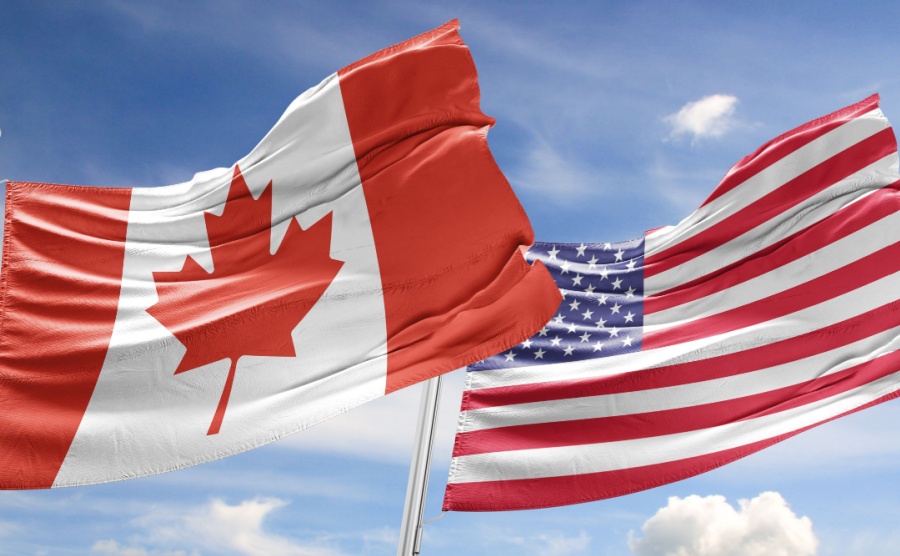English-speaking, check. Buzzing modern cities, check. Dramatic natural landscapes and access to the ultimate outdoors lifestyle, check. The North American continent certainly has the wow factor for foreign relocators. But should you pick Uncle Sam or The Great White North? Here are some differences between the USA and Canada to help you choose between the two.
Neighbouring First World countries with powerhouse economies, serious international clout and plentiful opportunities to realise a quality lifestyle – in 2024 the USA and Canada remain two of the world’s most popular migration destinations.
Sharing the world’s longest international border means they also share some obvious traits. One that hits new arrivals touching down from dinky Europe straightaway is North America’s sheer vastness and sense of space. Not surprising given the USA and Canada are ranked the world’s fourth and second largest countries by area respectively. This filters down to all levels of life – homes, gardens, roads, vehicles, railways, cars, retail outlets, leisure venues and even food portions are all larger than European counterparts. Embrace the bigness or go home!
Both countries are English-speaking too, albeit with regional nuances in accent, jargon and spelling. Canada notably has French as a second language, predominantly in the Quebec province where it is the official language. Something for relocators to bear in mind, as brushing up on that school French can improve your visa chances.

USA or Canada, where shoud you choose?
Both countries are within the same ballpark for flight time from the UK and wider Europe. Flying to a hub on the eastern seaboard area in either country, you’re looking at around eight hours in the air. Head to the west coast, expect a 10+ hour flight, depending on latitude.
So, which important things for a foreigner really set apart these two goliaths of the Western World?
Visa options and employment opportunities
Ease of entry and residency should be one of your first considerations. Broadly speaking, Canada’s visa system for foreign workers is regarded as less complex and more streamlined than the USA’s. The country now offers its online Express Entry facility, which enables the Government to match foreign workers to options using a points-based system combined with its popular Federal Skilled Worker Program.
Meanwhile, the regional boom in certain industries, such as mining and IT, means provinces can nominate and hire in-demand skilled workers via the Provincial Nominee Program (PNP).
After just three years of being a permanent resident you can apply for Canadian citizenship – less time than in the USA.
Residency visa options in the USA are famously convoluted, so using a migration specialist is highly recommended. Generally, UK workers opt for the employment-based Green Card route, so any of the EB (1-5) visas, with the investor (EB-5) a favourite with Brits starting or investing in a business
Work-life balance
Which country is happiest to live in? That will largely depend on you, of course, and whether work is more important to you or, for example, more holiday. On that measure, in the USA employees typically only get two weeks per year. Canada is not especially generous either, but you can expect at least another week.
In the OECD Better Life Index Canada and the USA both score very highly overall, but both fall down on work-life balance. The USA scores 5.2 while Canada scores 6.5 overal.
Affordability and cost of living
Canada is closer to Europe in its approach to welfare and taxation. Salaries tend to be lower than in the USA and generally taxes are higher but you get more back from the Canadian state.
For relocating families, state-funded education is available in both countries and is similar in standard. When it comes to university though, tuition fees in Canada are notably lower than in the USA, especially compared to the prestigious Ivy League institutions.
Canada wins again when it comes to the cost of healthcare, thanks to its free-to-access universal system, funded by taxation and not unlike the UK’s NHS. By contrast, healthcare in the USA is a mix of private and government-backed providers, and typically covered via your employer or expensive insurance.
Climate
While it’s probably not a great idea to choose Canada for winter warmth, there is plenty of sunshine there and even a desert. Bear in mind that much of Canada is further south than the UK. The diversity of climate there is far less than in the USA, with winters in the populated areas typically colder and of course snowy, while summers get into the high 20s°C, especially inland.
Your choice of climate is limitless in the USA, thanks to its geographical diversity and latitudinal span. Head nearer the equator to the southern states if you want winter sun in your new life, so California, Arizona and of course Florida, with its year-round theme parks and leisure attractions.
Population centres
Ninety per cent of Canada’s 40 million population lives within a 150-mile band along its US border. Around 60% are concentrated within Ontario and Quebec provinces, which include the hubs of Ottawa and Toronto, and Montreal respectively. The three other key metropolitan areas are Vancouver (British Columbia), and Calgary and Edmonton in Alberta. Much of Canada is largely uninhabitable.
By contrast, the 345 million population of the more densely populated USA is spread across its 50 states. California alone matches Canada’s population and is the most populated. Migrant hot spots Florida and New York rank third and fourth after Texas in second. Bottom-line, Uncle Sam offers a far greater diversity and choice of location.
Property availability
The USA invites all nationalities to come and own property. If you’re buying to rent out to holidaymakers, just beware of rental zone rules which restrict where vacation lets are permitted.
Canada’s property market is less accessible than the USA’s right now, at least for foreigners. This is due to the two-year ban on non-resident foreigners buying real estate in metropolitan areas. The law was introduced at the start of 2023 and remains in place until the end of 2024. The aim is to help cool the market to enable Canadians to get on the ladder. Rural, less populated areas are not affected, neither are foreigners with permanent residency status.
To be exempt, a property must be in a municipality (CA) with a core population of less than 10,000, or if it’s a metropolitan municipality (CMA) less than 100,000. So if it’s a swanky new city-pad in Vancouver or Toronto that you’re after, you’ll have to wait. But it does mean plenty of recreational properties, including ski homes and country cottages are still an option. As a note of caution, certain types of homes in certain cities attract a heavy tax if purchased by a non-resident foreigner.
Property affordability
In August, the USA’s National Association of Realtors reported that national median price of a single-family home had risen to over $422,000. By contrast, according to the Canadian Real Estate Association’s (CREA) latest report (July 2024) the national average home price in Canada is higher, namely CAD$667,317 ($494,300). Away from the prime real estate spots, it’s fair to say the USA had a far wider choice of affordable property.
In the USA, Florida remains the top destination for foreign buyers, with a median single-family home price of $416,990 (July, Florida Realtors) and accounting for 20% of all international purchases in the year to March 2024 (NAR). Texas (13%) and California (11%) are second and third, respectively, followed by Arizona (5 per cent), Georgia, New Jersey, New York and North Carolina (4% each).
California is home to highest concentration of prime real estate, being home to seven out of ten of the USA’s most expensive metropolitan areas.
Looking closer at Canada by province, the average home price (CREA, July 2024) in Quebec is CAD$525,732 ($389,400), in Ontario CAD837,685 ($620,500), in Alberta CAD$486,828 ($360,600) and in British Columbia CAD$962,537 ($707,750).
But how does that relate to wages? According to World Population Review, the USA has a 4.2 price to income ratio while Canada has 9.6. In other words, as a percentage of average incomes, average property prices are much more affordable in the USA. (The UK, incidentally, is 8.4, so half as affordable as the USA).

